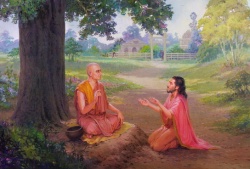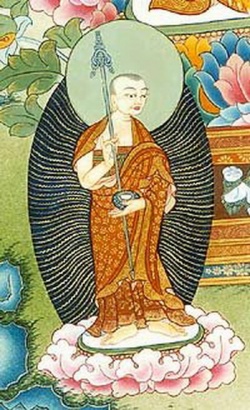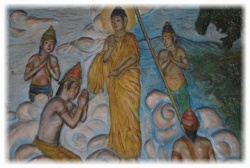Śāriputra
Śāriputra (Sanskrit: शारिपुत्र) or Sāriputta (Pāli) was one of two chief male disciples of The Buddha along with Maudgalyayana (Pali: Moggallāna), counterparts to the nuns Khema and Uppalavanna, named the two chief female disciples. He became an Arhat "foremost in Wisdom" renowned for his teaching and is depicted in the Theravada tradition as one of the most important disciples of The Buddha.
Name
Śāri was his mother's name and is also a particular bird's name. Putra meant boy or child.
He was also called Upatissa. This name came from his father's name, Tissa.
Biography
Śāriputra came from a Brahmin family and had already embarked on Life as a spiritual ascetic when he encountered the teachings of The Buddha. Śāriputra had a close friend Mahāmaudgalyāyana (Pāli: Mahāmoggallāna), another wandering ascetic. They both renounced the world on the same day and became disciples of the sceptic Sañjaya Belaṭṭhaputta before converting to Buddhism.
After hearing of The Buddha's teachings from a Monk named Assaji (Sanskrit: Asvajit), Śāriputra sought out The Buddha and became an adherent to his teachings. These two are often depicted together with The Buddha, and several sutras regard interactions between Śāriputra and Mahāmaudgalyāyana (who became renowned among the early Buddhists for his Mastery of supernatural powers).
In one somewhat comical scene involving the two friends, a mischievous yakṣha (Pāli: yakkha) decides that it will attempt to irritate Śāriputra by striking him on the head. Mahāmaudgalyāyana sees this occurring with his "divine eye" (a clairvoyant-like faculty often attributed to powerful Buddhist monks, as well as other South Asian ascetics), and unsuccessfully attempts to warn Śāriputra. However, due to his great spiritual Mastery, Śāriputra perceives the terrible blow that the yakkha delivers as only a Light breeze. Mahāmaudgalyāyana approaches and expresses his amazement that Sariputra barely noticed the terrible blow; Śāriputra replies in amazement that Mahāmaudgalyāyana was able to perceive the invisible creature that dealt the blow.
Śāriputra often preached with The Buddha's approval and was awarded the title of 'General of the Dharma' (Pāli: Dhammasenāpati) for his propagation of the teachings and is regarded as the founder of the Abhidharma tradition. However, The Buddha also lightly reprimanded Sariputta on occasion when he did not fully explain the Dhamma to a prince, or when he allowed a group of novice monks to become too loud.
Nevertheless, Śāriputra was one of the most highly praised disciples and on at least one occasion The Buddha declared him to be a true spiritual son and his chief assistant in "turning the Wheel of the Dhamma":
"If a person, rightly saying it of anyone, were to say, 'He is the Blessed One's son, his offspring — born of his mouth, born of the Dhamma, created by the Dhamma, his heir in the Dhamma, not his heir in material things,' he would be rightly saying it of Śāriputra if he were to say: 'He is the Blessed One's son, his offspring — born of his mouth, born of the Dhamma, created by the Dhamma, his heir in the Dhamma, not his heir in material things.' Sariputta, monks, takes the unexcelled wheel of Dhamma set rolling by the Tathagata, and keeps it rolling rightly."
Death
According to the Pali Canon, Sariputta died peacefully on the full moon day of the Kartika month of the ancient Indian Calendar, a few months before The Buddha, having achieved Parinibbana, and when Sariputta's assistant, Cunda, gave the news to Ananda, Ananda was very distressed. He passed the news along to The Buddha, who remained at peace, and chastised Ananda's reaction:
But, Ananda, haven't I already taught you the state of growing indifferent with regard to all things dear & appealing, the state of becoming separate, the state of becoming otherwise? What else is there to expect? It's impossible that one could forbid anything born, existent, fabricated, & subject to disintegration from disintegrating.
Just as if the largest limb were to fall off a great tree composed of heartwood, standing firm; in the same way, Sariputta has attained total Unbinding from this great community of monks composed of heartwood, standing firm. What else is there to expect? It's impossible that one could forbid anything born, existent, fabricated, & subject to disintegration from disintegrating.
The Stupa of Śāriputra (Sariputta)
Sariputta went to his native place with the permission of The Buddha, Nalaka, a Brahmin village as he wanted his mother who was still a non-Buddhist to be shown the correct path and Faith.
He died at the village called Nalaka after being successfully able to convert his mother and make her a path winner.
After his Body was cremated the bones were taken to The Buddha by Chunda and on The Buddha's instruction handed over to King Ajātashatru .
King Ajātashatru enshrined these relics in a Stupa which was venerated by the followers. After some time in BC 261 King Dharmasoka (Ashok) opened the Stupa on instructions received from Moggaliputtatissa who indicated the third Buddhist Council.
Śāriputra (Sariputta) as Krishna and Lakshman
In the Pali texts known as the Jātakas, one of Śāriputra's previous incarnation was also known as "Vasudeva" Krishna's father. The story in the Ghata Jataka differs from the Hindu story of Krishna in that Krishna has 9 brothers and a sister and is more of a conquering king, who along with his brothers, conquers all of the mystical land of Jambudvipa. Some contend that the Bhagavad Gita also advises to aspire for Refuge in Buddha, Gita 2:49, which states "Buddhau Saranam Anvicche" or "Take Refuge in Enlightenment".
Similarly one of the nine commonly used recollections (Anussati) of Buddha—"Purisa damma sarathi" which means "charioteer of heroic men". In the Gita for the first time, Krishna, who is a king himself, is shown as a mere charioteer and guide of the prince Arjuna. There are some who even contend that the Gita is a Buddhist text.
In another Jataka, the Dasaratha Jataka, Sariputta is reborn as Lakshmana or Lakkhan to Buddha's Rebirth as Rāma. In the Buddhist tale however, Sita is never kidnapped and Rama merely returns after exile as a glorious king to rule for thousands of years.
In Mahayana
While depictions of Śāriputra in the Pali Canon are uniformly positive, showing Śāriputra as a wise and powerful Arhat, second only to The Buddha, his depiction in some Mahayana sources has often been much less flattering, serving often as a counterpoint.
In the Vimalakīrti Sūtra, Śāriputra is depicted as the voice of the Hinayana or Śrāvaka tradition, which is presented in the [[Mahayana] sutras]] as a "less sophisticated" teaching. In this Sutra, Śāriputra is unable to readily grasp the Mahayana doctrines presented by Vimalakīrti and others, and is rebuked or defeated in debate by a number of interlocutors, including a female deity (deva) who refutes Śāriputra's "Hinayana" assumptions regarding Gender and form.
Here Shariputra questioned why, if so wise and capable, the deva has a female Body. The deva then proceeded to switching their sexes and stated that "in all things, there is neither male nor female" (non-duality).
However, in the Lotus Sutra, The Buddha does predict that Śāriputra will become a fully awakened Buddha one day, named Flower Glow Tathāgata, at which Śāriputra's mind is said to "dance with Joy".
A dialogue between Śāriputra and Avalokiteśvara is also the context of The Heart Sutra, a brief but essential text in the Mahayana Buddhist tradition.


